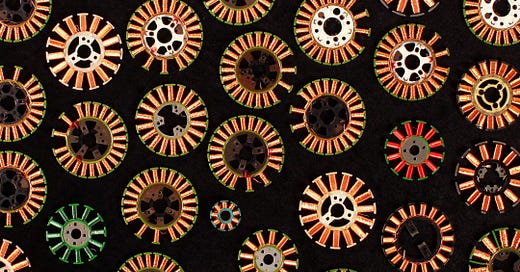Arc tags 2p, Rome hits tin. Both have visible mineralisation.
Good morning MINING AIM and welcome to my thought of the day.
Six weeks ago, Arc Minerals (LON: ARCM) shares sunk to circa 1.3p, driven by post-placing negativity and licence issues - fast forward to yesterday and the copper explorer has recovered to 2p per share. It turns out that when you have a circa $90 million Joint Venture with Anglo American to explore some of Zambia's most prospective tenure, alongside Botswana assays with visible chalcocite, you can bounce back fairly quickly from a little fear.
ARCM archives
I just wanted to highlight a video once again doing the rounds on social media of then Anglo Discovery Manager for Zambia, David Wood, leading a presentation on the geology of the Central African Copperbelt. It's a wonderful way to spend an hour, but as you are all time-strapped and many of you have allowed the Chinese Communist Party to strip you of an attention span, I've timestamped the key finding for you:
Expert analysis of the geology suggests that there is 30 million tons of undiscovered copper metal; Sentinel accounts for 5.2 million tons - and the leading question is where the remaining 24.8 million tons is.
The video was recorded on 27 May 2020, and the initial confidentiality and exclusivity agreement with Arc subsidiaries Zamsort and Zaco was signed with Anglo on 14 July 2020, in order to start conducting a technical review.
It took longer than expected, but the JV was eventually signed - and the working theory is that ARCM managed to negotiate the largest dollar Joint Venture in Zambia, with staged cash payments, because Anglo believes that much of that 'missing' 24.8 million tons is held within their licence areas.
Wood was also the Principal Geologist for FQM between April 2010 and November 2013. He knows the copperbelt.
Remember, ARCM's licences are some of the last Domes areas to be explored in detail and are within the trending arm of the major geological structure known as the Lufilian Arc, on the western flank of the Kabompo Dome. The Copperbelt is home to all the major copper mines in Zambia, which accounts for more than 80% of Zambian copper production.
The assets were previously explored through an Equinox Minerals and Anglo American Joint Venture during the late 1990s as part of the Kabompo Project. ARCM’s areas under license encompass nine of 30 exploration ranked targets, including the top seven ranked targets.
FQM’s Sentinel copper mine — which produces over 250,000 tonnes of copper per year — was originally ranked number 22 of the original 30 targets.
But even before we get too excited about Zambia (I'd guess we're about 500m deep by now), or Anglo's potential larger moves in the country, Botswana is now turning heads. Visible chalcocite does that to investors, and assays should start to come back as early as next week (though this may go into early September depending on how busy the lab is).
There is a natural buyer for the assets if ARCM chooses to go down this route, but you could also spin it out as its own IPO, or else form a new JV to explore further. There's a lot of optionality, and the expanded drilling suggests getting a partner on board should be fairly easy.
I am strongly hoping for fireworks, but as always, the proof will be in the pudding.
Rome hits tin
Where Arc Minerals is a retail favourite, Rome Resources' (LON: RMR) RTO is perhaps under the radar. Rome is exploring its Bisie North tin assets adjacent to Alphamin's Bisie deposit - which was discovered by the Rome team, and is the highest grade tin project in the world.
And like ARCM, it's hit visible mineralisation.
Summarising the key information from today's RNS:
Diamond drilling from the first rig on site at Kalayi (prospect at Bisie North) has come back with visible mineralisation; drillhole KBDD005 was drilled down to a depth of 164.5m, with the mineralised zone intersected roughly 60m below the KBDD003 drillhole from Rome's 2023 drilling campaign which had reported 12.5m at 1.03% Sn including 1m at 2.78% Sn and 1m at 7.12% Sn. The comparison with the 2023 drillhole suggests the potential for continuity of mineralisation at depth, in a manner previously only suspected.
Visible coarse grained cassiterite in KBDD005 was intersected in 3 narrow zones associated with quartz veining and silica flooding at 88.5m, 114m and 125m.The presence of cassiterite was confirmed from Niton XRF analyses. Cassiterite is a tin mineral and if it's in three zones, this suggests viable mineralisation is present.
Strong chlorite alteration together with shearing and quartz veining was noted throughout a 30m interval from 84 to 114m. This has the potential to host fine grained disseminated cassiterite, which will be assessed by lab quantitative analyses and would indicate a broader zone of mineralisation. Chlorite alteration is strongly associated with tin mineralisation at both Alphamin's Mpama North and South deposits indicating a similar style of mineralisation at Kalayi.
CEO Paul Barrett enthused 'We are delighted to see visible tin mineralisation in several intervals in the first hole of this drilling campaign and look forward to reporting assays as soon as they become available. We are also pleased to be mobilising additional drilling units to site to maintain an aggressive drilling campaign over the coming weeks and months.'
Two more drill rigs are being mobilised this week. Assays will start coming back soon. And it's all funded.
If the tin is visible, and one of the best exploration teams in the world is excited, then it's time for you to start getting excited too.
- Charles Archer, 20/8/2024





